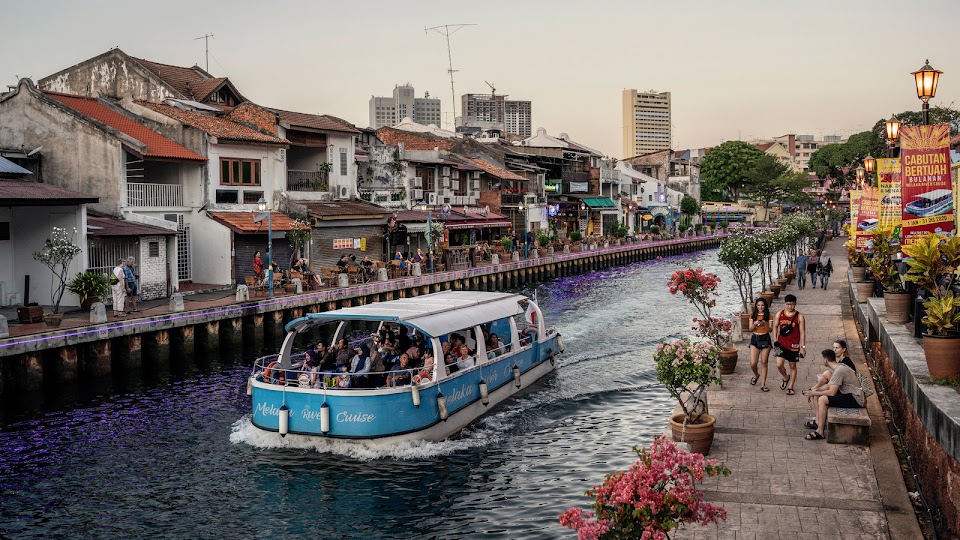THE “Gate to Hell” is one of the ways to get to Malacca’s colourful and historically rich Java Lane (Jalan Jawa).
Lorong Jambatan, a short and narrow alley of old shophouses in Kampung Pantai, earned its nickname of “Guimenguan” (Gate to Hell) during the Japanese Occupation.
The lane leads to a stairway linking the Kampung Jawa Bridge across the Malacca River.
Locals call it the “Ghost Bridge” because during Japanese rule
(1942-1945), severed heads of local Chinese businessmen killed by the dreaded
kempeitai(military police) were hung along its pillars.
But even before that, the 300-year old pedestrian crossing was deemed to be a spooky place because of the large number of suicides committed there.

Among the thriving businesses along Java Lane are several goldsmith shops.
Despite its dreadful name, the bridge offers a vantage point for heavenly views of the river and beyond.
Java Lane and Lorong Jambatan across the river used to be lined with ramshackle wooden houses with attap roofs before Tan Hoon Guan, an affluent local merchant, spearheaded a major development project in 1885.
Decades before it took on its hellish moniker, Lorong Jambatan was known as “Xin Jie” (New Street).
Hoon Guan and his brothers, Hoon Chiang and Hoon Hin, are credited with building the bridge and 85 shophouses on both sides of the river.
The area eventually grew into Malacca’s first nightlife hub while Kampung Jawa, further down the road, ended up as a sleazy red light quarter.
There were bars, opium dens, brothels, food stalls, shops stocked with a wide array of local and imported stuff and even a theatre along Java Lane.
During the 1920s and 30s, the theatre staged Bangsawan dramas in addition to Chinese opera and English plays based on the works of Shakespeare and such.
A check with old newspaper records showed that Victor Hugo’s Prince Hernani, starring K. Dean, Mohd Noor and Miss Tijah, was a big hit in Aug 1924.

Java Lane opens up to a landscaped area along the river, leading to Kampung Jawa.
Two months earlier, locals were raving over Abu Hasan an Arabian enactment,The Sculptor and The Three Dangers, both English dramas and a Malay play called Slendang Merah.
With the advent of movies, the theatre changed into a cinema for a brief period of time.
When the cinema went out of business with the entry of newer and bigger theatres built by the Shaw Brothers around City Park in nearby Jalan Bunga Raya, it was turned into a tenement house.
Sadly, the old drama theatre, built in 1887, was torn down in 2001, marking one of the most tragic losses of the historical city’s cultural heritage.
During China’s War of Resistance Against Japan (1931–1945), Java Lane was the focus of fund-raising efforts by the Chinese immigrants, mostly labourers, petty traders and hawkers.
Three underground groups declared “unlawful” by the British operated from the area. They were the Chinese Anti-Enemy Society, the Iron Blood Weeding Out Traitors Party and the Dare-to-Die Party.
They eventually merged to form an organisation with the even more mouthful name of: The Chinese Dare-to-Die Youthful Corps to Resist the Enemy and Weed out the Traitors with Iron and Blood for China’s Salvation.
From as late 1880s up to the 1970s, Java Lane was also a hotbed of triads and fierce gang fights.
Today, the street leading to Kampung Jawa is a rather quiet place.

Barber Tan You Hock using his traditional digging tool to skilfully remove the earwax of a customer.
Among its remaining thriving businesses include several goldsmith shops, one of the last barber shops offering earwax removal, a hardware store, a pet shop and the last remaining family-run bar, dating back to 1934.
The Sin Hiap Hin bar, is a living relic, reminiscent of the days when weather-beaten stevedores sat at its bars, quaffing cheap rice wine while waiting to unload goods from the next bumboat coming up the river.
Lian Suan, the wife of the owner, manages the bar with the help of her two sons, a veterinarian and a hotelier.
“It used to be packed in the old days and when people got drunk, there used to be violent brawls,” she said.
These days, it is only open during the day and has a string of regulars coming in for their shots of rice wine, herbal and fruit-based liquor, locally distilled whisky and cold canned beers.
Over the past few years, it has turned into somewhat of a tourist lure for those longing for the nostalgic spirit of the city.
One is always assured to seeing an interesting character or two at the Sin Hiap Hin bar.
Last week, I was pleasantly surprised to bump into Sarawak-based journalist and author James Ritchie drinking with his new-found friend from Tampin, Lim Peng Hock, there.
Across the road from the bar is a popular barber shop where Tan You Hock, 65, still uses the old-fashioned razor to shave beards and heads, and skilfully removes earwax for customers with his traditional digging tool.

The ‘Gate to Hell’ lane leads to this stairway, linking the Kampung Jawa Bridge across the Malacca River.
It costs RM5 to get earwax removed while the price of a regular haircut is RM10, just as it has been for decades.
Java Lane opens up to a landscaped area along the river, leading to the traditional commercial area of Kampung Jawa.
Before the arrival of shopping centres, this was the busiest business area in the city, within walking distance of the former central municipal market.
Although the operators of shophouses and businesses there today are predominantly Chinese, Kampung Jawa was indeed a Javanese village once.
The Portuguese called it Campon Jaio and during their rule and subsequent occupation by the Dutch, the inhabitants were mostly traders, fishermen and day labourers working at the port.
They were eventually assimilated into the local Malay population but with the redevelopment of the area, very few members of the community remained in the area.








